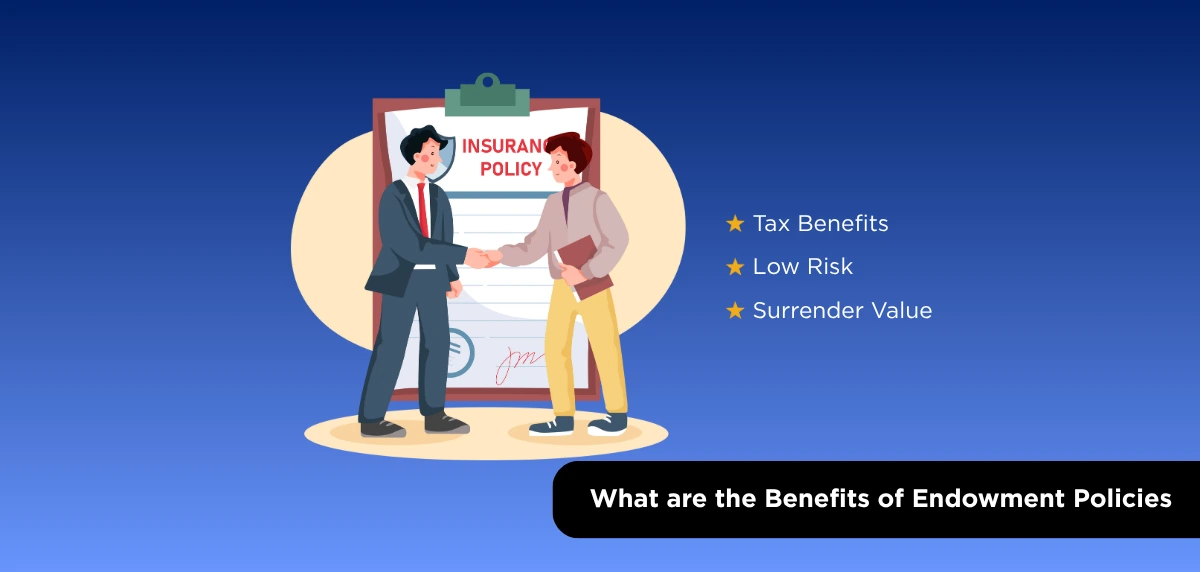When planning for the future, it’s not uncommon to be confused in choosing the right investment plans. You might wonder - how do you ensure financial security for your loved ones while also saving for long-term goals? This is where endowment policies step in as one of the financial tools. It combines the dual benefits of insurance coverage and savings. Let’s explore what endowment policies are and what are the key benefits of an endowment plan.
What is an Endowment Policy?
It is a life insurance plan that offers a lump sum payout either on maturity or in case of the policyholder's untimely demise during the policy term. It serves a dual purpose within one product:
Life Insurance Coverage
Financial protection for your family in case of an unfortunate event.
Savings Component
A disciplined way to accumulate wealth over the years, which you receive as a maturity benefit.
Endowment plans are best suited for individuals who want the safety of life cover while also building a financial corpus to meet goals like children’s education, marriage, or retirement.
Difference Between Term Insurance Policies and Endowment Plans**##
Term insurance policies and endowment plans are two popular life insurance options, each serving different financial needs. It is crucial to understand the difference between term insurance policies and endowment plans.
1. Definition
Term Insurance Policy:
Term insurance is a basic life cover that helps take care of your family's financial needs if the policyholder passes away during the policy period. This policy does not offer a maturity payout if the policyholder completes the term.
Endowment Plan:
An endowment policy is a life insurance plan that offers both protection and savings. It pays a lump sum either during the policy term if needed or at the end of the term if the plan is completed.
2. Purpose
Term Insurance:
It offers financial security to dependents in case of the policyholder’s untimely death.
Endowment Plan:
It covers life insurance and savings that help in accumulating wealth over time.
3. Coverage
Term Insurance:
Provides protection only if the policyholder passes away during the policy period.
Endowment Plan:
Covers the policyholder during the term and also pays a lump sum if they survive until the policy ends.
4. Premiums
Term Insurance:
Generally, it has low premiums, as they cover only the risk of death.
Endowment Plan:
Higher premiums due to the combined insurance and savings funds.
5. Perks
Term Insurance:
Death benefit paid to the nominee on the policyholder’s death. This policy does not offer a payout at maturity if the policyholder survives the term.
Endowment Plan:
A benefit is paid if a claim is made during the policy term. If the policyholder survives the full term, they receive the maturity amount along with any bonuses.
Advantages of an Endowment Policy
Here are some of the features of an endowment policy that can help you make an informed decision.
1. Dual Advantage
The main benefit of an endowment plan is that it offers both insurance and savings. A portion of your premium goes toward life insurance coverage, while the remainder is invested. You will receive a lump sum payout upon completion of the policy term.It’s a good option if you want to save for the future while staying protected.
2. Guaranteed Maturity Benefit
Unlike investments that rise and fall with the market, endowment policies give you a fixed payout at the end. This provides a guaranteed amount and any bonuses, which makes it a safer option for people who don’t want to take risks.
3. Tax Benefits**
An endowment policy can be a tax-efficient way to plan your savings.
Section 80C: Premiums paid qualify for deductions up to ₹1.5 lakh per annum.
Section 10(10D): The maturity or death benefits are typically exempt from tax, provided certain conditions are met.
4. Encourages Disciplined Savings
One of the underrated advantages of an endowment policy is that it helps you build a savings habit. Since you’re required to pay premiums monthly, quarterly, or annually, it instils financial discipline that can be difficult to achieve with more flexible investment options.
5. Low to Moderate Risk
Endowment investment plans are low in risk, because they aren’t linked to the market. This means your returns are steady and predictable, making them a good choice for people who want financial security rather than high but uncertain returns.
What to Know Before Investing in Endowment Plans**
Endowment plans can work well for those looking for a combination of life insurance and disciplined savings. However, they may not suit everyone’s financial goals or risk appetite.
Before you invest, it’s important to understand some of their key limitations:
1. Returns
Endowment plans typically offer guaranteed returns. But these may usually be lower than what you might earn from market-linked investments like mutual funds or ULIPs. If you're looking for high growth potential, an endowment plan may not deliver the kind of performance you expect from more aggressive investment options.
2. Lock-In Periods
These plans often come with long lock-in periods, usually ranging from 10 to 20 years. Once you commit, your money locked for a significant period. You may not have easy access to it if your financial needs change in the short term.
3. Higher Premiums Than Term Insurance
Compared to pure term insurance, endowment plans are more expensive. That’s because you're paying for both insurance and a savings component. For the same amount of life cover, premiums for endowment plans are significantly higher than those for term insurance.
4. Limited Flexibility
Endowment plans generally don’t allow partial withdrawals and adjustment of the premium value. This can be a drawback if your financial situation fluctuates aggressively over time.
If your main goal is to earn higher returns or maintain liquidity, endowment plans might not be the best fit. Always make sure your investment aligns with your financial goals, risk tolerance, and time horizon.
Endowment policies can be a good fit if you want a simple way to save money over time while also having life insurance protection. They’re especially suited for those who prefer low-risk, disciplined investing with the added benefit of life cover. So, if you’re comfortable locking your money for a while and prefer steady growth over big risks, an endowment plan might work well for you. Just ensure it fits with your financial goals.
** Tax exemptions are as per applicable tax laws from time to time.
# Bonus rate may vary from time to time based on Company’s Investment Performance.





















